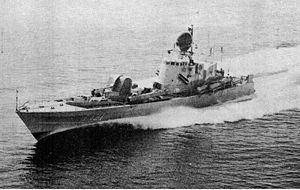Spica-class torpedo boat (Sweden)
This article includes a list of references, related reading, or external links, but its sources remain unclear because it lacks inline citations. (January 2017) |
 HSwMS Spica at sea
| |
| Class overview | |
|---|---|
| Name | Spica class |
| Builders | Götaverken and Karskrona Navy Yard |
| Operators | |
| Built | 1964–1966 |
| In service | 1966–1989 |
| Completed | 6 |
| Retired | 6 |
| Preserved | HSwMS Spica |
| General characteristics | |
| Type | Torpedo boat |
| Displacement | 220 tons standard, 235 tons full load |
| Length | 42.5 m (139 ft) |
| Beam | 7.1 m (23 ft) |
| Draught | 1.6 m (5 ft 3 in) |
| Propulsion | 3 shaft, Bristol Proteus gas turbines 12,750 hp (9,510 kW), 3 controllable pitch propellers |
| Speed | 40 knots (74 km/h; 46 mph) |
| Complement | 30 |
| Sensors and processing systems | Radar: Scanter 009, HSA M22 |
| Armament |
|
The Spica class was a class of six fast torpedo boats built for the Swedish Navy in the 1960s and decommissioned in the late 1980s. One ship, HSwMS Spica, is preserved as a museum ship in Stockholm, Sweden.
History
[edit]The ships were ordered in 1961 as part of a re-armament programme for defending Sweden's coastline. Tenders were sought from various European boat builders in the United Kingdom, Norway and Germany including Lurssen who offered the new Jaguar-class design. The Swedes ended up designing a bespoke vessel which became the template for subsequent Swedish fast attack craft.
Design
[edit]The hull was made of steel, unlike some other contemporary designs which used plywood. Although the boat had a relatively small hull and displacement, this provided a stable platform. The Bridge and Operations Room were located at the rolling and stamping centre of the ship which further improved stability for the crew especially in high seas. The boats were fitted with an NBC support system where the hull could be closed down in the event of having to operate in a nuclear fall-out area.
Machinery
[edit]The machinery consisted of three shafts powered by British built, Bristol Proteus gas turbines. Three MTU gas turbines were also installed as auxiliary generators
Armament
[edit]The torpedo armament consisted of six 533 mm (21 in) torpedo tubes which were positioned at an angle. Hydrogen-peroxide propelled, wire guided torpedoes were used. The gun armament consisted of a single Bofors 57 mm gun, which was capable of firing 200 rounds per minute over an effective range of 8,500 m (27,887 ft). The gun could engage both surface and airborne targets. There were also six 57 mm (2 in) and four 103 mm (4 in) rocket launchers capable of firing chaff, infrared countermeasures and illuminating projectiles (starshell). The torpedo boats had a scanning and a fire control radar with a basic fire control computer. There were plans to replace the torpedo tubes with anti-ship missiles in the 1980s but these plans were cancelled.
Ships
[edit]| Number | Name | Builder | Launched | Decommissioned |
|---|---|---|---|---|
| T121 | Spica | Götaverken | 26 April 1966 | 1989 – preserved as a museum ship |
| T122 | Sirius | Götaverken | 26 April 1966 | July 1985 |
| T123 | Capella | Götaverken | 26 April 1966 | 1989 |
| T124 | Castor | Karlskrona Navy yard | 25 October 1965 | July 1985 |
| T125 | Vega | Karlskrona Navy yard | 12 March 1966 | 1989 |
| T126 | Virgo | Karlskrona Navy Yard | 10 September 1966 | 1989 |
Twelve ships of a missile boat variant were built between 1971 and 1975 as the Norrköping class (Spica II).
Survivors
[edit]1 Spica-class torpedo boat is preserved as museum ship.
Surviving ships
[edit]Surviving parts
[edit]References
[edit]- [1]
- Budzbon, Przemysław; Chumbley, Stephen (1995). Gardiner, Robert (ed.). Conway's All the World's Fighting Ships 1947–1995. Annapolis, Maryland: Naval Institute Press. ISBN 1-55750-132-7. OCLC 34267261.
